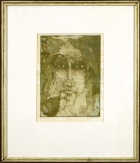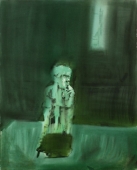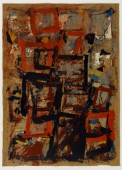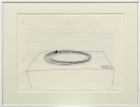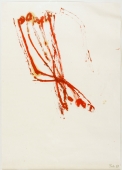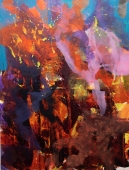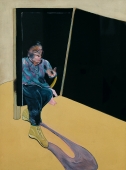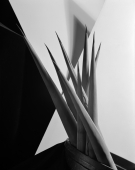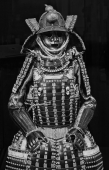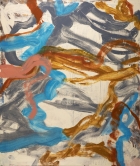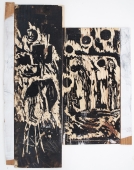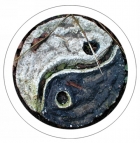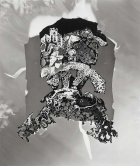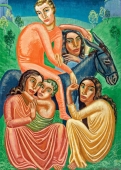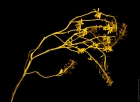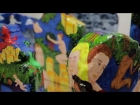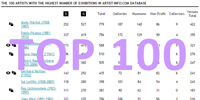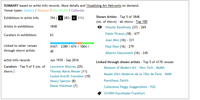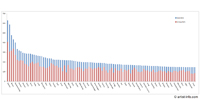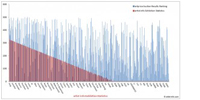
Artist | Henry Moore (1898 - 1986)
https://www.artist-info.com/artist/Henry-Moore
Biography
Biography
Henry Moore - A short biography
Henry Moore, the seventh of eight children of Raymond Spencer Moore and his wife Mary, was born in the small coalmining town of Castleford, Yorkshire, on 30 July 1898. Moore's childhood was typical of many. He was part of a large family with a loving mother and an intelligent father who was determined that all his children should be well educated and should advance in life as far as they were able with his encouragement. Moore went to infant and elementary schools in his home town, and entered Castleford Secondary School via a scholarship when he was eleven years old.
He was determined to sit the examinations for a scholarship to the local art college, but his father, ever a practical man, thought that he should follow an elder sister into the teaching profession. After a brief introduction as a student teacher, Moore began teaching full-time at his old school in Castleford. He was also asked, as an older boy, to design and carve a Roll of Honour for the names of all the former students who were marching off to war.
Soon it was to be Moore's turn; he enlisted at the age of eighteen and presently joined the 15th Battalion The London Regiment, known as the Civil Service Rifles. Shortly afterwards he was sent to France, where he and his regiment took part in the battle of Cambrai. Moore's active participation in the war ceased when he was gassed; he was sent back to spend two months in hospital. After convalescence he became a physical training instructor and later returned to France, but by then the war was over.
Moore went back to his teaching post in Castleford, but he now knew that teaching in school was not for him. He applied for and received an exserviceman's grant to attend Leeds School of Art. He continued to live inCastleford, travelling to Leeds by train every morning and back at night. There was no sculpture tutor at Leeds, but because Moore insisted that he wanted to study sculpture, one was appointed. At the end of his second year he won a scholarship to the Royal College of Art in London.
Now followed a period of intense activity for Moore, a thirsting for knowledge, an outpouring of ideas, many of them into the pages of the notebooks which have survived to this day. He studied the collections in the Victoria and Albert Museum and the Tate Callery, but his greatest interest lay in the British Museum, where he observed intently the collection of Mexican Aztec sculpture.
In 1924 Moore was appointed as sculpture instructor at the Royal College. It was there he met Irina Radetsky, a painting student at the college, whom he married a year later. The couple lived in Hampstead, where they mingled with many aspiring young artists and writers, including Ben Nicholson, Barbara Hepworth, Stephen Spender and Herbert Read.
Moore now became involved in the art life of London. His first commission, received in 1928, was to produce a sculpture relief for the newly opened Headquarters of London Transport at St James's Underground building. His first one-man exhibition, which consisted of forty-two sculptures and fifty-one drawings, opened at the Warren Gallery in 1928; it was followed by a second show consisting of thirty-four sculptures and nineteen drawings at the Leicester Galleries in 1931. From the 1931 exhibition came the first sale to a gallery abroad,: the small Head in ironstone, which was purchased by Dr. Max Sauerlandt, the director of the Museum für Kunst und Gewerbe in Hamburg. Not all the response was favourable, however. The art critic of the London Morning Post led the opposition with: 'The cult of ugliness triumphs at the hands of Mr Moore. He shows an utter contempt for the natural beauty of women and children, and in doing so, deprives even stone of its value as a means of aesthetic and emotional expression.
In the 1930s came three more one-man shows, all at the Leicester Galleries. Moore also participated in major group exhibitions of the time. In 1931 he exhibited three works in the Plastik exhibition in Zurich. In 1936 Alfred Barr, then director of the Museum of Modern Art in New York, borrowed Moore's Two Forms of 1934, in Pynkado wood, for his Cubism and Abstract Art exhibition; later Barr purchased the work, which became the first Moore sculpture in an American
public collection.
At this time Moore was a regular visitor to Paris. In 1934 he and Irina made their only visit to Spain, visiting Altamira, Madrid, Toledo and Barcelona. In 1936 Moore signed the manifesto urging the end of a policy of non-intervention in Spain. He attempted to go to Republican Spain as part of a delegation of English artists and writers, but their request for permission to travel was rejected by the British. Government. When war broke out in September 1939, the Moores were staying in a cottage at Kingston, in Kent; because of its proximity to Dover access was restricted, and the couple decided to return to London. Moore's teaching at Chelsea School of Art came to an end, however, when the college was evacuated to Northampton.
In 1940 their Hampstead home was damaged by a nearby bomb, and the Moores rented a house in Perry Green, a small hamlet in Hertfordshire, forty kilometres north of London. Here the artist would remain for the rest of his life. Moore was already forty-two years old, well known to those in the arts but as yet still unknown to the general public. Within six or seven years he would be widely recognised both in Britain and internationally. In the early 1940s he had begun to make drawings of people sheltering from air-raids in the London Underground. These drawings, together with those he made subsequently in the coalmines, are considered among his greatest achievements.
Moore's first retrospecitve exhibition was held at Temple Newsam, Leeds, in 1941. The same year he received the commission for a Madonna and Child at St Matthew's Church, Northampton. In 1945 came his first honorary doctorate, from the University of Leeds. His daughter Mary was born in 1946, the year of his first foreign retrospective exhibition, at the Museum of Modern Art, New York. Now the abuse which Moore had received in the thirties turned into the praise of the fifties and sixties. Honours, honorary degrees, prizes, commissions and awards were showered upon him. The International Sculpture Prizes at the 24th Venice Biennale in 1948 and at the 2nd Sao Paulo, Bienal in 1953, his appointment as a Companion of Honour in 1955 and to the Order of Merit in 1963, the award of the Erasmus Prize in 1968 and the Goslar Prize in 1975 are just a few from a chronology of over seventy accolades emanating from a dozen countries. At the same time, the demands for exhibitions of his work continued to increase, both in number and in scale. By the end of the seventies the number of exhibitions had grown to an average of forty a year, ranging from the very small (a loan of a few graphics to a school or village hall), through dealers' shows and touring exhibitions organised in more remote corners of the world by the British Council, to major international retrospectives with huge budgets taking years of detailed planning and preparation. In 1972 came the Florence exhibition, the largest and most impressive to that date, the exhibition which set the standard for all subsequent 'blockbusters'. In 1981 the Madrid exhibition, the first major foreign exhibition in Spain for over forty years, marked the return of that country into the cultural life of Europe. Then came the retrospective at the Metropolitan Museum in New York during 1983, the large survey exhibitions in Hong Kong and Japan in 1986, and in 1987 the first major posthumous exhibition at the National Gallery of Modern Art in New Delhi.
But while the world was honouring him, Moore was all the time giving back. A gift of over two hundred sculptures and drawings and a complete collection of graphics was made to the Art Gallery of Ontario in 1974. Over thirty major piecesand another collection of graphics went to the Tate Gallery in 1978. Other gifts have included drawings to the British Museum and graphic work to the Victoria and Albert Museum and the British Council in London. In 1980 Moore laid the foundation stone for the Henry Moore Centre for the Study of Sculpture in Leeds. This opened in 1982 and is endowed by the Henry Moore Foundation. A few years before his death in 1986 Moore gave the whole estate at Perry Green with its studios, houses, cottages and collection of work to the Trustees of the Henry Moore Foundation to administer in perpetuity, charging them with the allocation of grants, bursaries and scholarships to promote sculpture within the cultural life of the country. Moore's relationship with Germany stretches back over forty years. In 1931 he made the first sale of a work abroad to the Museum für
Kunst und Gewerbe in Hamburg. The art historian and critic Herbert Read lectured in Germany in the late 1940s and introduced Henry Moore to an eager German art scene. It was in the late 1950s that Harry Fischer, an Austrian art dealer in London, introduced Moore to Hermann Noack, head of the Berlin bronze foundry. From then to his death in 1986 Moore sent a large number of his works to be cast in Berlin, and of the many casts made there two, The Archer 1964-65 and Large Divided Oval: Butterfly cast 1985-86, have been sited in the city. During the 1950s and 1960s many important German museums and collections acquired works by Henry Moore.
Harry Fischer was also instrumental in organising the purchase and subsequent gift of a complete collection of Moore's graphic work to the Wilhelm Lehmbruck Museum in Duisburg. Among German cities in which large outdoor sculptures can be seen are Bielefeld, Duisburg, Düsseldorf, Essen, Hamburg, Hanover, Munich, Nuremberg, Recklinghausen, Stuttgart and Wuppertal. The largest of Moore's warrior figures was acquired by the city of Goslar in 1975, and the sculpture is now known as the Goslar Warrior. In the same year Moore became the first recipient of the Goslar Prize.
In 1957 Moore was awarded the Stefan Lochner Medal by the city of Cologne; in 1961 he was elected a member of the Akademie der Künste in Berlin, in 1968 he was given the Federal Republic's Order of Merit, and in 1972 he was elected a Foreign Member of the Orden pour le Mérite für Wissenschaften und Künste. The former Chancellor of Germany, Helmut Schmidt, was a great admirer of Moore's work and a personal friend of the artist. It was he who succeeded in acquiring Large Two Forms 1966-69 for the Bundeskanzleramt in Bonn, a sculpture which was also cast by Noack in Berlin.
A British Council exhibition of Moore's sculptures and drawings travelled to Hamburg and Düsseldorf in 1949 and since then his work has been seen throughout Germany. Recent major shows have included an exhibition in 1979 which travelled to Bonn and Ludwigshafen, a sculpture exhibition in Munich in 1983, a tour of his war drawings to Berlin, Leipzig, Halle and Dresden in 1984 and a thematic exhibition based on the theme of Mother and Child which was seen in four German towns in 1992.
Text by: David Mitchinson / Julie Summers, in: Henry Moore - Ethos und Form; exhibition catalogue, Moore-Foundation / Much Hadham, Pforzheim / Bad Homburg v.d.H., 1994, p.15 ff., ISBN 3-9603529-4-3
About the work
About the work
Henry Moore's late bronze sculpture
As stated elsewhere in this catalogue, Henry Moore is very well known in Germany where his works are to be seen in major cities from the north to the south. However, it is the works from the 1950s and 1960s which are most familiar in Germany. The late bronzes are relatively under-represented in public collections, the notable exceptions being the Goslar Warrior (1974), sited in the city from which the sculpture takes its title, and the Large Divided Oval: Butterfly (cast 1985 / 86) outside the Kongresshalle in Berlin. This exhibition seeks to redress the balance.
The works shown here are executed in bronze and come exclusively from the collection of the Henry Moore Foundation. When this was set up by Moore in 1977 one of its principal objectives was to take care of the substantial body of work he gave it. This collection was added to during the following decade until Moore's death in 1986. This collection of large sculptures dates principally from the last three decades of Moore's life and represents his journey through the abstraction of the 1960s back to the humanism and late realism of his last fifteen years.
The exhibition seeks to chart the progress of this return to a form of realism in his bronze works. It opens with two-piece sculptures from 1959 and 1960, explores the monumental abstract forms of the 1960s and leads, by means of the sculpture Goslar Warrior (LH 641, cat. 20, p. 117) to the three final works in the exhibition dating from 1982 and 1983.
Moore has been described as the 'English Romantic'. Peter Fuller wrote: 'Moore longed to create a spiritual and yet humanist art which touched upon the universal truths which lay behind the trappings of myth; for Moore abstraction was a means to this end rather than an end in itself.'(1) Such sculptures as Working Model for Sheep Piece and Working Model for Hill Arches testify to Fuller's theory. Superficially the latter sculpture is pure abstraction and yet its natural curves and towering strength have led to many comparisons of this piece with animal and human forms. David Sylvester, art historian and the earliest cataloguer of Moore's work, described this sculpture in 1968 in the following terms: 'Hill Arches, with its flamboyant energy, its superb symmetry, its coiled tension, ist predatory menace, its formality and its sheer magnificence, is like an especially ritualistic and flashy mating display.'(2) Of the Sheep Piece he wrote that it suggested 'an asexual longing of bodies for contact with others, like the nuzzling of blind puppies ...'.'(3) As these remarks demonstrate, it is the essence of being which is the most striking on close study of these abstract sculptures. Their human qualities are hidden just beneath the skin.
From the great abstract works of the 1960s, many of which are represented here in their working model size, Moore moved slowly towards a new realism in his sculpture. He re-explored the female form, addressing himself not so much to her physical form as to her true essence, not to her femininity but to the whole strength of her womanhood. Two sculptures in this exhibition, Reclining Mother and Child 1975 (LH 649, cat. 21, p. 119) and Working Model for Mother and Child: Hood 1982 (LH 850, cat. 37, p. 151) embody Moore's philosophy of this period. The Reclining Mother and Child continues two main themes of Moore's work, namely the reclining figure and mother and child. Here the abstracted child figure is distanced from the more realistic mother - it does not even make eye contact with her. Indeed the child has been construed as a menacing presence, although perhaps one should think of it as a self-assured creature partially protected by the mother's bulky form and secure on her lap. How much more protective and intimate is the mother in the second sculpture, Working Model for Mother and Child: Hood. Here the child is shielded by the whole body and spirit of its mother. The group has a peaceful, contemplative quality which reminds the viewer of the 1944 Madonna and Child (Fig. 28, p. 36) and indeed it is interesting to note that this sculpture was enlarged in travertine marble in 1983 and is on long loan to St. Paul's Cathedral, London.
In the 1950s Moore's works had been closely based on landscape. From the late 1960s onwards he moved towards a more recognisably human form of greater bulk. In the case of Reclining Figure: Hand (LH 709, cat. 30, p. 137): 'The result is not perceived by the viewer as an anatomical reality, but experienced as an internal awareness of the physical forces and stresses of the human body.'(4)
Among this great series of monumental figures comes the Goslar Warrior (LH 641, cat. 20, p. 117), a testament to the fragility of the human form, a reminder of the mutilation of war and nevertheless a poem in human and spiritual dignity. Professor Lichtenstern makes the connection in her essay with the antique references in this sculpture, that is to say, the similarity between it and one of the large figures from the Acropolis. The transformation of the underlying source, however, simply serves to link Moore 'with the classical tradition of sculpturemaking, in which the human figure is never abandoned'.(5) It is surely also the scale of the human tragedy encompassed in this pathetic and yet dignified body which renders the sculpture one of the most majestic pieces of the 1970s.
Like the Goslar Warrior, which has its roots in Moore's work of the 1950s, Reclining Figure: Holes (LH 656, cat. 24, p. 125) also looks back to an earlier period in Moore's work. Its antecedents are found in the carved reclining figures of the 1930s when the ar tist was opening up stone and wood for the first time, challenging the form and the material simultaneously. In this later sculpture, however, the holes are 'created' by the placement of the limbs, the first being provided by the left arm bent at right angles, the second by the junction of elbow and knee and so on. Above all it demonstrates that Moore was always a carver. This sculpture was created in the maquette form and then later enlarged in elmwood to a length of 222 cm. Moore never lost the ability to scale up his ideas from the smallest maquette to the largest possible expression of the form. After the Second World War Moore worked principally in plaster, a medium which greatly pleased him because it allowed him to model whilst the plaster was wet and carve it when dry. He worked on a small scale, creating the maquette - a small object which could be created on a turntable and held in the hand. This would later be cast in bronze and perhaps enlarged by Moore's assistants again in plaster. The resulting work - the so-called working model - would also be cast in bronze and might then be further enlarged by the assistants to produce the lifesize or over life-size final version. In latter years models were generally produced in polystyrene and covered with a layer of plaster to give Moore an opportunity to create a surface on the sculpture or indeed to make alterations to the proportions of the enlargement.
The working model sized sculptures, of which thirteen are shown in this exhibition, represent an important aspect of Moore's oeuvre from the 1960s on. Initially conceived to allow an intermediate stage between the minute maquette and the monumental, over-life size bronze, they were seen as a stage in the development of the final form, a stage at which the relationships of one form to another could be addressed, perspectives could be changed or proportions altered. The Working Model for Locking Piece 1962 (LH 514, cat. 8, p. 93) is suitably close to its maquette, now lost, to render the explanation of its existence plausible, namely that Moore chanced upon a pair of small pebbles which locked together when twisted or turned. He was very taken with this idea and worked it into a sculpture. The working model revolves on its circular turntable and is one of the most three-dimensionally complete of all the 1960s sculptures. The rough hewn faces of the cut off ends of the 'pebbles' or rocks refer back to the works of the 1950s which were greatly influenced by landscape. A slightly less obvious example of this can be seen in the Working Model for Stone Memorial (LH 491 a, cat. 6, p. 89) which embodies all the essence of the landscape tradition in Moore's work whilst embracing also the most abstract elements in his sculpture of this period - two forms pierced, interlocking and yet almost in battle with one another. The tension between the two parts echoes in certain respects the Working Model for Locking Piece.
The theme of the interlocking sculpture is taken further in this exhibition via the Maquette for Reclining Interior Oval (LH 537, cat. 10, p. 97) into the two sculptures from 1968 entitled Two Piece Sculpture: Interlocking (LH 581, cat. 12, p. 101) and Maquette for Two Piece Sculpture No. 11 (LH 582, cat. 13, p. 103). The latter forms lead the way to the monumental Large Vertebrae 1978 / 9 in Dallas which is 12.2 metres long. They represent more strongly than almost any other work shown here Moore's extraordinary ability to work on a very small scale towards an enormous end whilst forgoing none of the ideas inherent in the original maquette.
Working Model for Two Piece Reclining Figure: Cut (LH 757, cat. 33, p. 143) is certainly one of the more abstract two-piece sculptures of the late 1970s but its power lies in the physical tension of the torso opposing the leg section, the gap between each element as taut as two opposing magnets forced together or perhaps two attracting magnets dragged apart. A cast of the largest size of this sculpture can be seen in Strasbourg.
The monumental sculpture Three Piece Reclining Figure: Draped (LH 655, cat. 23, p. 123), the largest of Moore's three-piece reclining figures, betrays in her draped leg section her part-origins in the Helmet Heads of the 1960s. Indeed this work is related to another sculpture in the exhibition entitled Maquette for Helmet Head No.6, (LH 650, cat. 22, p. 151) the final enlargement of which, Figure in a Shelter, sited in the Peace Park in Guernica, northern Spain, is one of the largest pieces ever created by Moore. The tension in Three Piece Reclining Figure: Draped is brought about by the unequal size of the leg elements and their distance from the rather more recognisable human torso section. Seen first from the leg end, as she is both in Pforzheim and Bad Homburg, she works as a marvellously foreshortened figure, almost as viewed through a wide-angled lens, whereas from the side one is aware of the smooth contours and the dominating head section. Moore himself addressed the problem of dealing with a European sculpture inheritance which had become confused and 'overgrown with moss, weeds ...' He said '... it may now be no longer necessary to close down and restrict sculpture to the single (static) form unit. We can now begin to open out. To relate and combine together several forms of varied sizes, sections and directions into one organic whole.' This sculpture demonstrates exactly this theory which Moore first voiced in 1937 and continued to work out during his long career.
Notes
(1) Peter Fuller, 'An English Romantic', in Henry Moore, exhibition catalogue ed. Susan Compton, Royal Academy of Arts, London 1988, p.39.
(2) Henry Moore at the Serpentine, exhibition catalogue with introduction by David Sylvester, n.p.
(3) Ibid.
(4) Compton (see note 1), catalogue entry no. 197., p.269.
(5) Ibid., catalogue entry no. 191, p.266
Text by: Julie Summers, in: Henry Moore - Ethos und Form; exhibition catalogue, Moore-Foundation / Much Hadham, Pforzheim / Bad Homburg v.d.H., 1994, p.15 ff., ISBN 3-9603529-4-3
Bibliography Catalogues raisonnés
Bibliography Catalogues raisonnés
Henry Moore: Complete Sculpture. Vol. 1, 1921-48 (titled: Sculpture and Drawings), edited by Herbert Read, London 1944; Second edition by David Sylvester / Vol. 2, 1949-1954, editied by David Sylvester, London 1955 / Vol. 3, edited by Alan Bowness, London 1965 / Vol. 4, 1964-73, editied by Alan Bowness, London 1977 / Vol. 5, 1974-80, edited by Alan Bowness, London 1983, 2nd eition1994 / Vol. 6, 1981-86, editied by Alan Bowness, London 1988. All volumes are published by Lund Humphries, London
Henry Moore: Catalogue of Graphic Work, edited by Gerald Cramer, Alistair Grant and David Mitchinson, Vol. 1 1931-72, Genf 1973; Vol. 2, 1973-75, Genf 1976, Vol. 3, 1976-79, Genf 1980, Vol. 4, 1980-84, Genf 1988. All volumes published by Cramer, Genf.
Henry Moore: Complete Drawings, edited by Ann Garrould, Vol. 5, 1977-81, published in May 1994 ; Vol. 6, 1982-83, will be published in automne 1994. Publisher: Lund Humphries, London
Bibliography Selected Publications
Bibliography Selected Publications
Argan, Giulio Carlo: Henry Moore, Stuttgart 1989
Ayrton, Michael / Moore, Henry; Giovanni Pisano, Bildhauer, Frankfurt 1970
Berthoud, Roger: The Life of Henry Moore, London / New York 1987
Clark, Kenneth: Henry Moore Drawings, London / New York 1974
Garrould, Ann: Henry Moore Drawings, London / New York 1988
Grigson, Geoffrey: Henry Moore, Harmondworth 1943
Grohmann, Will; Henry Moore, Berlin 1960
Hall, Donald: Henry Moore - The Life and Work of a Great Sculptor, London / New York 1960
Henry Moore at the British Museum, Introduction and commentary by Henry Moore, photographs by David Finn, London 1981 / New York 1982.
Henry Hoore: Energy in Space, photographs by John Hedgecoe, München / Boston 1974
Henry Moore: Mother and Child Etchings, introduction by Gail Gelburd, Much Hadham 1988
Henry Moore on Sculpture, edited by Philip James, London 1966 / New York 1967; revised edition: 1971
Henry Moore: Unpublished Drawings, edited by David Mitchinson, Turin / New York 1971
Hofmann, Werner: Henry Moores Schriften und Skulpturen, Frankfurt 1959
Lichtenstern, Christa: Metamorphose in der Kunst des 19. und 20. Jahrhunderts, Vol.1: Die Wirkungsgeschichte der Metamorphosenlehre Goethes von Philipp Otto Runge bis Joseph Beuys, Weinheim 1990; Vol.2: Metamorphose - Vom Mythos zum Prozessdenken. Ovid-Rezeption / Surrealistische Asthetik / Verwandlungsthematik der Nachkriegskunst, Weinheim 1992
Lichtenstern, Christa: Henry Moore Zweiteilig Liegende No.1, Landschaft wird Figur, Frankfurt 1994
Mitchinson, David / Stallabrass, Julian: Henry Moore, London 1992
Moore, Henry / Levine, Gemma: Henry Moore Wood Sculpture, London 1983
Neumann, Erich; Die archetypische Welt Henry Moores, Zürich / Stuttgart 1961
Packer, William: Henry Moore: An Illustrated Biography, with photographs by Gemma Levine, London / New York 1985
Read, Herbert: Henry Moore. A Study of His Life and Work, London 1965 / New York 1966. German translation: München / Zürich 1967
Read, John: Henry Moore: Portrait of an Artist, New York 1979
Riedl, Peter Anselm: Henry Moore: König und Königin, Stuttgart 1957
Russell, John: Henry Moore, London / New York 1968, revised pocket book edition: Harmondsworth 1973
Seldis, Henry J .: Henry Moore in America, London 1973
Spender, Stephen: In Irina's Garden, London 1986
Steingriber, Erich: Henry Moore: Maquetten, München 1978
Strachan, Waiter: Henry Moore: Animals, London 1983
Bibliography Major exhibition catalogues
Bibliography Major exhibition catalogues
Henry Moore, edited by James Johnson Sweeney. Museum of Modern Art, New York 1947
Sculpture and Drawings by Henry Moore, edited David Sylvester, London 1951
Henry Moore: Sculpture 1950-1960, edited by Bryan Robertson, Whitechapel Art Gallery, London 1960
Henry Moore, bearb. v. David Sylvester, London / New York 1968
Henry Moore, Rijksmuseum Kröller-Müller, Otterlo / Museum Boymans-Van Beuningen, Rotterdam 1968
Henry Moore Exhibition in Japan, edited by David Thompson, Tokyo 1969
Moore e Firenze, edited by Giovanni Carandente, Florenz 1972
The Drawings of Henry Moore, edited by Alan G. Wilkinson, Art Gallery of Ontario, Toronto 1977 / Tate Gallery, London 1978
Henry Moore: Sculptures et dessins, introduction by Dominique Bozo, Paris 1977
Henry Moore: 80th Birthday Exhibition, Bradford Art Galleries and Museums, Bradford 1978
Henry Moore at the Serpentine, edited by David Sylvester, London 1978
The Henry Moore Gift, introduction by John Russell, Tate Gallery, London 1978
Henry Moore 1921-1981, edited by David Mitchinson and Juliet Wilson-Bareau, Madrid 1981
Henry Moore, Samsung Foundation of Art and Culture, Seoul 1982
Henry Moore en Mexico: Escultura, Dibujo, Gràfica de 1921 a 1981, Instituto Nacional de Bellas Artes-Cultura, Mexico City 1982
Henry Moore, edited by José Maria Salvador, Museo de Arte Contemporàneo, Caracas 1983
Henry Moore: 60 Years of His Art, edited by William S. Lieberman, Metropolitan Museum of Art, New York 1983
Henry Moore: Shelter and Coal Mining Drawings, text by Julian Andrews, Ministerium für Kultur der Deutschen Demokratischen Republik, Berlin 1984
The Art of Henry Moore, texte by David Mitchinson and William Packer, Metropolitan Art Museum, Tokyo; Art Museum, Fukuoka 1986
Henry Moore, New Delhi 1987, edited by Ann Elliott and David Mitchinson, text by Norbert Lynton, National Gallery of Modern Art, New Delhi; British Council, London 1987
Henry Moore, edited by Susan Compton, Royal Academy of Arts / London 1988
Henry Moore, edited by David Mitchinson, Fondation Pierre Gianadda, Martigny / Electa, Mailand 1989
Henry Moore: The Human Dimension, edited by Norbert Lynton, Moskau 1991
Henry Moore 1898-1986, text by Nick Waterlow, Art Gallery of New South Wales, 1992
Henry Moore in the Bagatelle Gardens, Paris, photographs by Michel Muller, essay by David Coyen, London 1993
Henry Moore and the Sea, edited by Angela Dyer and Julie Summers, traveling exhibition through England, 1993
Bibliography Major Articles
Bibliography Major Articles
Fischer, Wolfgang / Trier, Alice: Henry Moore in Deutschland, in: Jahresring 87188, Jahrbuch f(jr Kunst und Literatur, Stuttgart 1987,S.233-253
Lichtenstern, Christa : Henry Moore and surrealism, in: The Burlington Magazine CXXIII / 944 (Nov. 1981), S. 645-658
Lichtenstern, Christa: Henry Moore in der Begegnung mit Goethe: Die Prometheus-Illustrationen, in: Ausst. Kat.: "Goethe in der Kunst des 20.Jahrhunderts", bearb. v. Petra Maisak, Bonn-Bad Godesberg / Frankfurt / Düsseldorf 1982, S. 5-43
Lichtenstern, Christa: Voraussetzungen und Entwicklungen naturisthetischer Perspektiven in der Skulptur und Plastik nach 1945, in: Marburger Jahrbuch ffir Kunstwissenschaft, Bd. 23, 1993, S. 19-42
Meyer zur Capellen, Jürg: Henry Moore als Fotograf der eigenen Werke, in: Pantheon, Jahresheft 1985, S. 183-191
Morphet, Richard: Four Piece Composition: Reclining Figure, in: The Tate Gallery 1976-78. Illustrated Catalogue of Acquisitions, London 1979, S. 116-122
Seidel, Max: Henry Moore interpretiert das Werk Giovanni Pisanos, in.. Pantheon, XXIX / 5 (Sept.-Okt. 1971), S.413-16
Trier, Eduard: Der Bildhauer Henry Moore, in: Anschnitt 3,11. Jg. 1959, S. 29-34
Trier, Eduard: Erinnerungen an Henry Moore, in: Festschrift zum 65. Geburtstag
von Siegfried SaIzmann, edited by Kunstverein in Bremen, Heidelberg 1993,S.77-82
Wedewer, Rolf: Zur Naturvorstellung Henry Moores, in: Pantheon, XXVIII / 2, 4-7
(1980), S. 186-193
The Moore bibliography counts at present 15.000 publicatins in ca. 40 languages,
compiled by Alexander Davis, Henry Moore Bibliography, at present 4 volumes, London / Much Hadham 1992 / 94.
Internet
Internet
 offers / Requests offers / Requests  |
About this service |
|---|
 Exhibition Announcements Exhibition Announcements  |
About this service |
|---|
 Visualization |
Learn more about this service | ||
|---|---|---|---|

Interested in discovering more of this artist's networks?
3 easy steps: Register, buy a package for a visualization, select the artist.
See examples how visualization looks like for an artist, a curator, or an exhibition place: Gallery, museum, non-profit place, or collector.

Exhibition History

|
SUMMARY based on artist-info records. More details and Visualizing Art Networks on demand. Venue types: Gallery / Museum / Non-Profit / Collector |
||||||||||||
| Exhibitions in artist-info | 327 (S 117/ G 210) |
Did show together with - Top 5 of 3977 artists (no. of shows) - all shows - Top 100
|
||||||||||
| Exhibitions by type | 327: 128 / 113 / 84 / 2 | |||||||||||
| Venues by type | 206: 87 / 61 / 56 / 2 | |||||||||||
| Curators | 113 | |||||||||||
| artist-info records | Jan 1928 - Jun 2022 | |||||||||||
|
Countries - Top 5 of 20 United States (85) Germany (84) United Kingdom (84) Italy (18) Switzerland (12) |
Cities - Top 5 of 94 London (74) New York (44) Los Angeles (10) Berlin (10) Chicago (9) |
Venues (no. of shows )
Top 5 of 206
|
||||||||||
Curators (no. of shows)
Top 5 of 113
|
| Whitechapel Gallery | G | Feb 2022 - Jun 2022 | London | (417) | +0 | |
| Blazwick, Iwona (Curator) | +0 | |||||
| S|2 Gallery - Sotheby's | G | Jul 2019 - Aug 2019 | London | (7) | +0 | |
| Ford, Sue Grayson (Curator) | +0 | |||||
| Summers, Cherith (Curator) | +0 | |||||
| J. Paul Getty Museum | G | Jan 2017 - Apr 2017 | Brentwood / Westwood | (36) | +0 | |
| Haus der Kunst | G | Oct 2016 - Mar 2017 | München | (189) | +0 | |
| Wilmes, Ulrich (Curator) | +0 | |||||
| Lorz, Julienne (Curator) | +0 | |||||
| Brantl, Sabine (Curator) | +0 | |||||
| Schneider, Anna (Curator) | +0 | |||||
| Milnes, Daniel (Curator) | +0 | |||||
| Deutsche Bank Collection - Artists | S | Apr 2015 - Apr 2015 | Frankfurt am Main | (1) | +0 | |
| Gagosian Gallery - London Davies St | S | Feb 2015 - Apr 2015 | London | (77) | +0 | |
| Keep reading |















